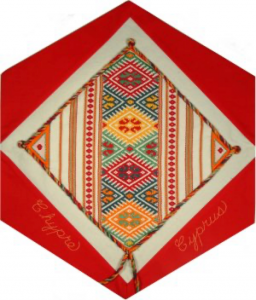Cyprus

The Block
Cyprus has a long and rich tradition in weaving that includes a wide variety of techniques and designs. This block provides an example of the most important Crypriot styles called Phyti weaving. It was donated by Vrissiis Mavrou-Paidoussis. Phyti is named for the village where it is said to have been developed and is often used to decorate napkins, bed covers and tablecloths. The woven cloth features distinctive geometric designs (called ploumia by weavers) worked in traditional colours on a background of natural, undyed cotton. A frame of twisted cord, made from the same thread used in the weaving, adds the finishing touch to the piece.
Cultural Profile
Cyprus is a large, picturesque island in the eastern Mediterranean Sea. Its name comes from the Greek word for copper (kupros), as the island once supplied the ancient world with much of its copper. The copper was later mixed with tin to make bronze. The people, predominantly farmers who work the land surrounding their villages, represent two main ethnic groups, Greeks in the south, and Turks in the north. Each group maintains its own customs, and to a great extent, its own identity. The remainder of the population is comprised of Armenians and other ethnic groups. Greek and Turkish are both official languages, while Armenian and Arabic are recognized languages. English is widely spoken in larger centres, a legacy of the British protectorate that lasted until 1960.
Cypriots are proud of their cultural heritage, which dates back more than 9,000 years, and the island is full of reminders of its history. Relics from all eras including Greek temples, Roman mosaics and 15th century frescoes which continue to influence today’s artists.
Specific villages specialize in different art forms such as pottery, silver and copperware, basket weaving, tapestry making, decorative buttons made from dom (ivory nuts) and Lefkara’s famous lacework. The techniques for this lacework were brought over by the Venetians in the 15th century and perfected by Cypriot women. Traditional crafts are kept alive through institutions such as the Cyprus Handicraft Service.
The country is also known for its folk dancing, music and Tsiattista, the poetic duelling that may remind Western listeners of contemporary rap battles, though the music and rhythms differ greatly. Cyprus’ famous colourful, traditional costume displays delicate embroidery on the vests, skirts, head kerchiefs and women’s long pantaloons.
The 2011 census report indicates that there are currently over 4,800 Cypriots living in Canada, many of whom left their homeland for social and economic reasons.
Sponsor: Thousand Island Quilters, Brockville
